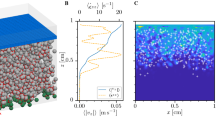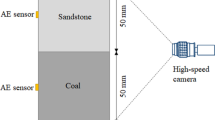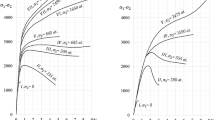Abstract
Brittle failure limits the compressive strength of rock and ice when rapidly loaded under low to moderate confinement. Higher confinement or slower loading results in ductile failure once the brittle–ductile transition is crossed. Brittle failure begins when primary cracks initiate and slide, creating wing cracks at their tips1,2,3. Under little to no confinement, wing cracks extend and link together, splitting the material into slender columns which then fail. Under low to moderate confinement, wing crack growth is restricted and terminal failure is controlled by the localization of damage along a narrow band. Early investigations proposed that localization results from either the linkage of wing cracks1,2,3 or the buckling of microcolumns created between adjacent wing cracks4,5. Observations of compressive failure in ice6 suggest a mechanism whereby localization initiates owing to the bending-induced failure of slender microcolumns created between sets of secondary cracks emanating from one side of a primary crack. Here we analyse this mechanism, and show that it leads to a closed-form, quantitative model that depends only on independently measurable mechanical parameters. Our model predictions for both the brittle compressive strength and the brittle–ductile transition are consistent with data from a variety of crystalline materials, offering quantitative evidence for universal processes in brittle failure and for the broad applicability of the model.
This is a preview of subscription content, access via your institution
Access options
Subscribe to this journal
Receive 51 print issues and online access
$199.00 per year
only $3.90 per issue
Buy this article
- Purchase on Springer Link
- Instant access to full article PDF
Prices may be subject to local taxes which are calculated during checkout



Similar content being viewed by others
References
Brace, W. F. & Bombolakis, E. G. A note on brittle crack growth in compression. J. Geophys. Res. 68, 3709–3713 (1963).
Horii, H. & Nemat-Nasser, S. Brittle failure in compression: Splitting, faulting, and brittle-ductile transition. Phil. Trans. R. Soc. Lond. A 319, 337–374 (1986).
Ashby, M. F. & Hallam, S. D. The failure of brittle solids containing small cracks under compressive stress states. Acta Metall. 34, 497–510 (1986).
Peng, S. & Johnson, A. M. Crack growth and faulting in cylindrical specimens of Chelmsford Granite. Int. J. Rock Mech. Min. Sci. Geomech. Abstr. 9, 37–86 (1972).
Bazant, Z. & Xiang, Y. Size effect in compression fracture: Splitting crack band propagation. J. Eng. Mech. 123, 162–172 (1997).
Schulson, E. M., Iliescu, D. & Renshaw, C. E. On the initiation of shear faults during brittle compressive failure: A new mechanism. J. Geophys. Res. 104, 695–705 (1999).
Reches, Z. & Lockner, D. A. Nucleation and growth of faults in brittle rocks. J. Geophys. Res. 99, 18159–18173 (1994).
Riedel, H. & Rice, J. R. in Fracture Mechanics: Twelfth conference 112–130 (American Society for Testing and Materials, 1980).
Schulson, E. M. The brittle compressive fracture of ice. Acta Metall. Mater. 38, 1963–1976 (1990).
Hellan, K. Introduction to Fracture Mechanics 1–302 (McGraw-Hill, New York, 1984).
Qi, S. & Schulson, E. M. in 14th Int. Symp. on Ice 521–527 (A. A. Balkema, Potsdam, New York, 1998).
Nixon, W. A. & Schulson, E. M. A micromechanical view of the fracture toughness of ice. J. Physique 48, C1-313–C1-319 (1987).
Thouless, M. D., Evans, A. G., Ashby, M. F. & Hutchinson, J. W. The edge cracking and spalling of brittle plates. Acta Metall. 35, 1333–1341 (1987).
Iliescu, D. Contributions to Brittle Compressive Failure of Ice. PhD Thesis, 1–284, Thayer School of Engineering, Dartmouth College (2000).
Heard, H. C. in Rock Deformation, Mem. Geol. Soc. Am. (eds Griggs, D. T. & Handin, J.) Vol. 79, 193–226 (Geol. Soc. Am., New York, 1960).
Weiss, J. & Schulson, E. M. Grain-boundary sliding and crack nucleation in ice. Phil. Mag. A 80, 279–300 (2000).
Cooke, M. L. Fracture localization along faults with spatially varying friction. J. Geophys. Res. 102, 22425–22434 (1997).
Pollard, D. D. & Segall, P. in Fracture Mechanics of Rock (ed. Atkinson, B. K.) 227–349 (Academic, San Diego, California, 1987).
Horii, H. & Nemat-Nasser, S. Compression-induced microcrack growth in brittle solids: axial splitting and shear fracture. J. Geophys. Res. 90, 3105–3125 (1985).
Schulson, E. M. & Buck, S. E. The ductile-to-brittle transition and ductile failure envelopes of orthotropic ice under biaxial compression. Acta Metall. Mater. 43, 3663–3668 (1995).
Schulson, E. M. & Nickolayev, O. Y. Failure of columnar saline ice under biaxial compression: Failure envelopes and the brittle-to-ductile transition. J. Geophys. Res. 100, 22383–22400 (1995).
Kirby, S. H. Tectonic stresses in the lithosphere: Constraints provided by the experimental deformation of rocks. J. Geophys. Res. 85, 6353–6363 (1980).
Hacker, B. R. & Christie, J. M. in The Brittle–Ductile Transition in Rocks (eds Duba, A. G., Durham, W. B., Handin, J. W. & Wang, H. F.) (American Geophysical Union, Washington DC, 1990).
Wang, Z. & Ji, S. Deformation of silicate garnets: Brittle-ductile transition and its geological implications. Can. Mineral. 37, 525–541 (1999).
Gowd, T. N. & Rummel, F. Effect of confining pressure on the fracture behaviour of a porous rock. Int. J. Rock Mech. Min. Sci. Geomech. Abstr. 17, 225–229 (1980).
Mogi, K. Some precise measurements of fracture strength of rocks under uniform compressive stress. Rock Mech. Eng. Geol. 4, 41–55 (1966).
Shock, R. N. & Heard, H. C. Static mechanical properties and shock loading response of granite. J. Geophys. Res. 79, 1662–1666 (1974).
Tullis, J. & Yund, R. A. Experimental deformation of dry Westerly granite. J. Geophys. Res. 82, 5705–5718 (1977).
Brace, W. F. & Byerlee, J. D. in Failure and Breakage of Rock (ed. Fairhurst, C.) (American Institute of Mining, Metallurgical and Petroleum Engineers, New York, 1967).
Gottschalk, R. R., Kronenberg, A. K., Russell, J. E. & Handin, J. Mechanical anisotropy of gneiss: Failure criterion and textural sources of directional behavior. J. Geophys. Res. 95, 21613–21634 (1990).
Acknowledgements
This work was supported by the US National Science Foundation, the Army Research Office, and the Office of Naval Research.
Author information
Authors and Affiliations
Corresponding authors
Supplementary information
Supplementary Materials Part A
Summary: The complete derivation of the brittle-ductile transitional strain rate (equations 1a,b in the text).
Following Horri and Nemat-Nasser, the mode I stress intensity factor K I associated with the initiation of a secondary crack at the end of a sliding segment along the primary crack is estimated by


where w is the acute angle between the primary and secondary crack planes, 2c is the length of the sliding segment, and t* is the excess shear stress defined as


where q is the angle between the applied compression and the primary crack, m is the coefficient of friction along the sliding segment, and s 1 and s 3 are the greatest and least principal compressive stresses. Assuming an optimally oriented slip patch (q = 45°) and secondary crack (w = 45°), equations (A.1) and (A.2) can be written


where the confinement ratio R = s 3/s 1.
The stress concentration at the tip of the sliding segment results in a region near the tip of the segment where the stress exceeds the yield stress of the material. Under plane strain conditions, Irwin estimated the radius of this region as


where s y is the yield stress. For brittle materials, the yield stress is similar to the tensile strength, s t, which can be approximated as a function of the primary crack size and the critical stress intensity factor K Ic as


where Y is a geometrical factor of order unity. Combining equations (A.4) and (A.5) yields


At secondary crack inititation, K I = K Ic, which implies r e/c ≈ 1/(6π).
The key assumption of the secondary, or "comb", crack model for the brittle to ductile transition is as follows: The zone of stress concentration defined by equation (A.6) results in the development of inelastic deformation within this zone. Under lower loading rates, creep deformation occurs quickly enough to sufficiently relax the stress concentration and inhibit the initiation of secondary cracks, suppressing brittle failure. Under higher loading rates, creep deformation is not sufficient to fully relax the stress concentration, resulting in the initiation of secondary cracks. Specifically, we assume that brittle failure will occur when the size of the region of creep deformation r c is less the size of the zone of stress concentration r e. Thus the criterion for the brittle to ductile transition can be expressed as


The time dependent size of the region of creep deformation can be obtained from the Riedel-Rice model of creep zones around non-interacting cracks loaded under far-field tension by invoking secondary or power-law creep, defined by
 . Thus
. Thus


where the angular function F ≈ 1/2 and the dimensionless factor a ≈ 1. For ice and many rocks, n ≈ 3 . Following Schulson, the loading time t can be approximated as the ratio of the critical stress intensity factor and the loading rate,
 , where the loading rate is determined as the product of the partial derivatives
, where the loading rate is determined as the product of the partial derivatives
 . The derivative
. The derivative
 is a modified Young’s modulus E’ (i.e., reduced by damage) and
is a modified Young’s modulus E’ (i.e., reduced by damage) and
 is the applied strain rate. Differentiating equation (A.3) results in the final derivative
is the applied strain rate. Differentiating equation (A.3) results in the final derivative
 . Assuming E’ ≈ E, then equation (A.8) can be rewritten as
. Assuming E’ ≈ E, then equation (A.8) can be rewritten as


At the brittle-ductile transition, the stresses are nearly sufficient to initiate secondary cracks. Thus K I ≈ K Ic. Defining the dimensionless strain rate as


then equations (A.7) and (A.9) can be combined to express the transitional strain rate in non-dimensional form as


This expression is consistent with the work of Horii and Nemat-Nasser in that they also noted the sensitivity of the transitional strain rate to the ratios
 and R. Equation (A.10b) extends this earlier work by yielding a single closed-form estimate for the transitional strain rate that specifically includes friction as well as both ratios.
and R. Equation (A.10b) extends this earlier work by yielding a single closed-form estimate for the transitional strain rate that specifically includes friction as well as both ratios.
Supplementary Materials Part B
Summary: The complete derivation of the failure strength expression (equations 2-4 in the text).
We argue that the failure of the microcolumns created between secondary cracks begins a cascade of successive microcolumn failure and the development of the macroscopic failure plane. In contrast to earlier microcolumn models, failure of the microcolumns is not thought to occur via buckling of the columns. This is because observations of brittle compressive failure in ice suggest that the compressive stress needed to buckle microcolumns is 2-3 orders of magnitude greater than the measured uniaxial compressive strength. Instead, we argue that the microcolumns fail by bending due to frictional drag of the free end of the microcolumn along the primary crack.
According to our model, the stress needed to initiate brittle failure is the stress required for the first microcolumn to fail. We estimate this stress as follows. Frictional drag along the primary crack induces a bending moment in the microcolumn. The bending moment plus the axial load on the column generates mixed-mode loading at the tip of the secondary crack bounding the microcolumn. Failure of the microcolumn occurs when the stress concentration at the secondary crack tip results in the out-of-plane extension of the secondary crack. If we assume that this situation is similar to the case of an edge crack in a brittle plate, then we can invoke the analysis of Thouless et al.. In the long-crack limit, the energy released, G, per unit advance of the secondary crack per unit thickness of the microcolumn is estimated as


where E’ = E/(1-n 2) and E and n are Young’s modulus and Poisson’s ratio, respectively. M is the bending moment, per unit thickness of the microcolumn, induced by frictional drag along the sliding segment. The shear stress acting on the free end of the microcolumn is to equal to frictional resistance ms n, where s n is the normal stress across the primary crack. For an optimally oriented parent crack (q=45°), we have s n = (s 1/2)(1+R), resulting in the bending moment m(s 1/2)(1+R)wh, where R = s 3/s 1. This moment is resisted by the moment created as the column slides past its adjacent column. This can be approximated as mRs 1hw. Thus the net moment acting on the microcolumn is


At microcolumn failure, the energy release rate G achieves a critical value, which can be related to the mode I and II critical stress intensity factors K Ic and K IIc as


Experimental data on the value of K IIc in ice, rock and other brittle materials are limited, but generally suggest that K IIc is of the same order as K Ic . Letting K IIc = K Ic and combining equations (B.1-3) allows the compressive strength of the material. s f, to be expressed as


where a = h/w is the aspect, or slenderness, ratio of the microcolumns.
The above expression for the failure strength requires information on the geometry of the microcolumns. We derive expressions for this geometry in terms of fundamental material properties. First consider the height h of the microcolumns, which is controlled by the length of the secondary cracks. When a secondary crack forms, it extends to accommodate frictional sliding along the primary crack. For R ≥ 0, the extension of the secondary crack is stable, with the length given by


where 2c is the length of the primary crack. For R>0, the length of the secondary crack asymptotically approaches the limiting value


Sliding along the primary crack also perturbs the stress field ahead of the sliding segment where the grain boundary has yet to fully decohere. As noted in the text, decohesion is a viscous process and thus the rate of decohesion depends on the shear stress acting on the grain boundary. In the absence of the secondary crack, the shear stress t along the grain boundary ahead of the sliding segment can be determined from the stress field ahead of a mode II crack


where t o is the shear stress in the absence of any slip along the grain boundary, the excess shear stress t* is defined by equation (A.2), and where x is the distance along the decohering primary crack from the tip of the sliding segment. In terms of the normalized distance from the tip of the sliding segment c = x/c, equation (B.7) can be written


The increased shear stress ahead of the sliding segment along the primary crack accelerates the decohesion of the grain boundary in this region, eventually resulting in frictional sliding along the newly decohered region and in the extension of the sliding segment. However, because the shear stress concentration only extends a short distance from the tip of the sliding segment, the sliding segment will only extend a short distance before its further propagation is again inhibited by a region of the grain boundary that has yet to fully decohere. If the applied strain rate is above the transitional strain rate, the material at the new tip of the sliding segment will not have time to completely relax the stress concentration there, resulting in the formation of a secondary crack. As this secondary crack grows, the shear stress concentration which still exists ahead of the newly extended sliding segment will locally decohere the grain boundary and permit the sliding segment to again extend a short distance, with the subsequent initiation of another secondary crack. In this manner, a set of secondary cracks is created in a consecutive manner.
In the above scheme, the spacing of the secondary cracks is controlled by the extent of the zone of shear stress concentration ahead of the sliding segment. The boundary of this zone is defined by the location at which the shear stress begins to significantly increase, resulting in a greater rate of dechesion. Here we approximate this boundary as the location where the magnitude of the gradient of the normalized shear stress (equation B.8) exceeds unity.


Solving for c = w/c and noting that for an optimally oriented grain boundary (q = 45°), t*/t o = 1-m(1+R)/(1-R) yields


Dividing equation (B.6) by (B.10) gives the aspect ratio a=h/w of the microcolumns. Substituting this result into equation (B.4), the compressive strength of the material can be expressed in dimensionless form s D as


Rights and permissions
About this article
Cite this article
Renshaw, C., Schulson, E. Universal behaviour in compressive failure of brittle materials. Nature 412, 897–900 (2001). https://doi.org/10.1038/35091045
Received:
Accepted:
Issue Date:
DOI: https://doi.org/10.1038/35091045
This article is cited by
-
Synchrotron 4D X-Ray Imaging Reveals Strain Localization at the Onset of System-Size Failure in Porous Reservoir Rocks
Pure and Applied Geophysics (2022)
-
Discrete element modeling of planetary ice analogs: mechanical behavior upon sintering
Granular Matter (2022)
-
Crack initiation stress of brittle rock with different porosities
Bulletin of Engineering Geology and the Environment (2021)
-
Stress-Dependent Deformation and Permeability of a Fractured Coal Subject to Excavation-Related Loading Paths
Rock Mechanics and Rock Engineering (2021)
-
Experimental and numerical investigations on the failure processes and mechanisms of composite coal–rock specimens
Scientific Reports (2020)
Comments
By submitting a comment you agree to abide by our Terms and Community Guidelines. If you find something abusive or that does not comply with our terms or guidelines please flag it as inappropriate.



